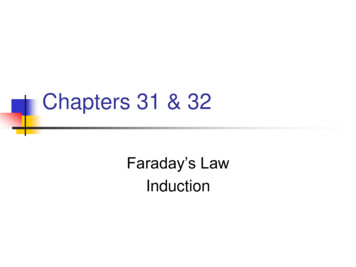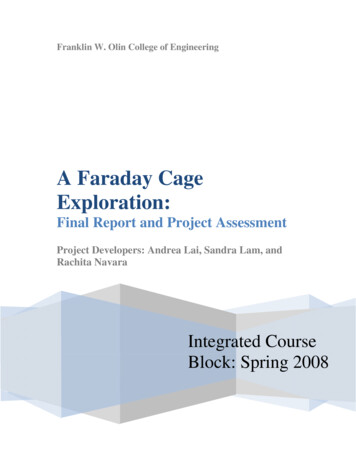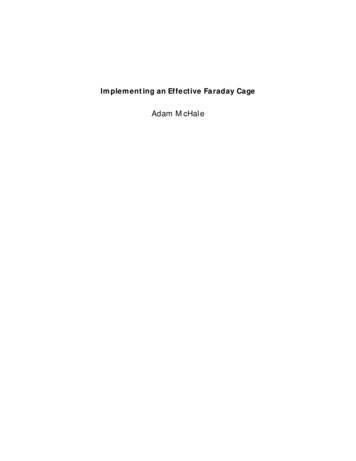
Transcription
Chapters 31 & 32Faraday’s LawInduction
Michael Faraday Great experimentalphysicist1791 – 1867Contributions to earlyelectricity include: Invention of motor,generator, andtransformerElectromagneticinductionLaws of electrolysis
A constantcurrent producesa magnetic field.Does a constantmagnetic fieldproduce acurrent? Let’s tryan experiment.
Ec6:Electromagnetic Induction Moving a permanentmagnet inside a coilof wire induces anemf which thendrives a currentthrough the circuit.
EMF Produced by a ChangingMagnetic Field, 1 A loop of wire isconnected to asensitive ammeterWhen a magnet ismoved toward theloop, the ammeterdeflects The direction waschosen to be towardthe right arbitrarily
EMF Produced by a ChangingMagnetic Field, 2 When the magnet isheld stationary,there is nodeflection of theammeterTherefore, there isno induced current Even though themagnet is in the loop
EMF Produced by a ChangingMagnetic Field, 3 The magnet is movedaway from the loopThe ammeter deflects inthe opposite direction
Induction An induced current is produced by achanging magnetic fieldThere is an induced emf associated withthe induced currentA current can be produced without abattery present in the circuitFaraday’s law of induction describes theinduced emf
MFM06VD1: Faraday’s law
Faraday’s Law of Induction The emf induced in a circuit is directlyproportional to the rate of change of themagnetic flux through that circuitMathematically, d dtB
Faraday’s Law Remember B is the magnetic fluxthrough the circuit and is found by B dAFor a circuit of N loops (all with Bthrough them), an emf is induced inevery loop. Faraday’s law becomesB Nd dtB
Faraday’s Law – Example Assume a loopenclosing an area Alies in a uniformmagnetic field BThe magnetic fluxthrough the loop is B BA cos The induced emf is - d/dt (BA cos )
Ways of Inducing an emf - d/dt (BA cos ) Magnitude of B can change with timeArea enclosed, A, can change with timeAngle can change with timeAny combination of the above can occur
Quick Quiz 31.1A circular loop of wire is held in a uniform magnetic field, withthe plane of the loop perpendicular to the field lines. Which of thefollowing will not cause a current to be induced in the loop?(a) crushing the loop(b) rotating the loop about an axis perpendicular to the field lines(c) rotating the loop about an axis parallel to the field lines(d) keeping the orientation of the loop fixed and moving it alongthe field lines(e) pulling the loop out of the field
Quick Quiz 31.1Answer: (c) and (d).In all other cases there is a change in the magnetic fluxthrough the loop.
Quick Quiz 31.2The figure below shows the strength versus time for a magneticfield that passes through a fixed loop, oriented perpendicular tothe plane of the loop. The magnitude of the magnetic field at anytime is uniform over the area of the loop. Rank the magnitudes ofthe emf generated in the loop at the five instants indicated, fromlargest to smallest.(a) a, b, c, d(b) b, d, a, c(c) c, d, b, a(d) d, c, a, b(e) e, a, d, c
Quick Quiz 31.2Answer: (c). Specifically: c, d e, b, a.The magnitude of the emf is proportional to the rate of change ofthe magnetic flux. This is proportional to the rate of change of themagnetic field – i.e. the change in the slope of the graph. Themagnitude of the slope is largest at c. Points d and e are on astraight line, so the slope is the same at each point. Point drepresents a point of relatively small slope, while a is at a point ofzero slope because the curve is horizontal at that point.
Quick Quiz 31.3Suppose you would like to steal power for your home fromthe electric company by placing a loop of wire near atransmission cable, so as to induce an emf in the loop (anillegal procedure!). You would have to(a) place your loop so that the transmission cable passesthrough your loop(b) simply place your loop near the transmission cable
Quick Quiz 31.3Answer: (b).The magnetic field lines around the transmission cable willbe circular, centred on the cable. If you place your looparound the cable, there are no field lines passing through theloop, so no emf is induced. The loop must be placed next tothe cable, with the plane of the loop parallel to the cable tomaximize the flux through its area.
Application Faraday’sLaw – Pickup Coil The pickup coil of an electricguitar uses Faraday’s lawThe coil is placed near thevibrating string and causes aportion of the string to becomemagnetizedWhen the string vibrates themagnetized segment producesa changing flux through the coilThe induced emf is fed to anamplifier
Ec17: ElectromagneticInduction – Jumping Rings Unbroken aluminium ringsplaced around the iron core ofan inductor are repelledupwards when a conductor isconnected to an AC source.The ring jumps much higher iffirst cooled in liquid nitrogen.Note: doesn’t work if an ironring is used because theferromagnetic attraction ismuch larger than therepulsion due to the Eddycurrents.
MFA06AN1: Lorentz force ona conductor moving through amagnetic field
Motional emf A motional emf is oneinduced in a conductormoving through aconstant magnetic fieldThe electrons in theconductor experiencea force, FB qv x Bthat is directed along ℓ
Motional emf, cont. Under the influence of the force, the electronsmove to the lower end of the conductor andaccumulate thereAs a result of the charge separation, an electricfield E is produced inside the conductorThe charges accumulate at both ends of theconductor until they are in equilibrium withregard to the electric and magnetic forces
Motional emf, final In equilibrium, qE qvB or E vBA potential difference is maintainedbetween the ends of the conductor aslong as it continues to move through themagnetic fieldIf the direction of the motion is reversed,the sign of the potential difference isalso reversed
MFM07AN1: emf generatedby wire cutting magnetic field
Sliding Conducting Bar A bar moving through a uniform field and theequivalent circuit diagram Assume the bar has zero resistanceThe work done by the applied force appears asinternal energy in the resistor R
Sliding Conducting Bar, cont. Magnetic flux is B BlxThe induced emf isd B dt ddt Blx Thus the current isI R BlvR Bldxdt Blv
Sliding Conducting Bar: Forces The applied force Fapp does work on the conductingbarThis moves the charges through a magnetic fieldThe magnetic force FB BIl opposes the motionIts direction is opposite to the applied force (righthand rule)Since the bar is moving at constant speed (i.e. noacceleration) we must have Fapp FB BIl
Sliding Conducting Bar,Energy Considerations The change in energy must be equal to the transferof energy into the system by this workThe power input is equal to the rate at which energyis delivered to the resistorThus:2P F app v IlB v 2B l vR2 2R
Quick Quiz 31.4As an airplane flies from Sydney to Melbourne, it passesthrough the Earth’s magnetic field, which is directedupwards. As a result, a motional emf is developed betweenthe wingtips. Which wingtip is positively charged?(a) the left wing(b) the right wing
Quick Quiz 31.4Answer: (b).The Earth’s magnetic field has an upward component in thesouthern hemisphere. As the plane flies south, the right-handrule indicates that positive charge experiences a forcedirected toward the west. Thus, the right wingtip becomespositively charged and the left wingtip negatively charged.
Quick Quiz 31.5In the figure, a given applied force ofmagnitude Fapp results in a constant speed vand a power input P. Imagine that the forceis increased so that the constant speed ofthe bar is doubled to 2v. Under theseconditions, the new force and the newpower input are(a) 2F and 2P(b) 4F and 2P(c) 2F and 4P(d) 4F and 4P
Quick Quiz 31.5Answer: (c).The force on the wire is of magnitude Fapp FB IℓB, with I Blv/R. Thus, the force is proportional to the speed and the forcedoubles. Because P Fappv, the doubling of the force and thespeed results in the power being four times as large.
Quick Quiz 31.6You wish to move a rectangular loop of wire into a region ofuniform magnetic field at a given speed so as to induce anemf in the loop. The plane of the loop remains perpendicularto the magnetic field lines. In which orientation should youhold the loop while you move it into the region of magneticfield in order to generate the largest emf?(a) with the long dimension of the loop parallel to thevelocity vector(b) with the short dimension of the loop parallel to thevelocity vector(c) either way—the emf is the same regardless oforientation.
Quick Quiz 31.6Answer: (b).Since -Blv, because B and v are fixed, the emf dependsonly on the length of the wire moving in the magnetic field.Thus, you want the long dimension moving through themagnetic field lines so that it is perpendicular to the velocityvector. In this case, the short dimension is parallel to thevelocity vector.
Rail guns
Ec15: ElectromagneticInduction – Lenz’s rings An eddy current is induced inthe unbroken ring but not inthe broken one.The unbroken ring moves in adirection to oppose the forcethat caused the change influx.
Lenz’s Law Faraday’s law indicates that the inducedemf and the change in flux haveopposite algebraic signsThis has a physical interpretation thathas come to be known as Lenz’s lawDeveloped by German physicistHeinrich Lenz
Lenz’s Law, cont. Lenz’s law: the induced current in aloop is in the direction that creates amagnetic field that opposes the changethat produced itThe induced current tends to keep theoriginal magnetic flux through the circuitfrom changing
Lenz’s law in action
MFA07AN1: Lenz’s law frommagnet moving near wire
Quick Quiz 31.7The figure below shows a magnet being moved in thevicinity of a solenoid connected to a sensitive ammeter. Thesouth pole of the magnetis the pole nearest thesolenoid, and the ammeterindicates a clockwise(viewed from above)current in the solenoid.The person is:(a) inserting the magnet(b) pulling it out
Quick Quiz 31.7Answer: (a).Because the current induced in the solenoid is clockwisewhen viewed from above, the magnetic field lines producedby this current point downward in the Figure. Thus, theupper end of the solenoid acts as a south pole. For thissituation to be consistent with Lenz’s law, the south pole ofthe bar magnet must be approaching the solenoid (as likepoles repel).
Quick Quiz 31.8The figure below shows a circular loop of wire beingdropped toward a wire carrying a current to the left. Thedirection of the induced current in the loop of wire is(a) clockwise(b) counterclockwise(c) zero(d) impossible to determine
Quick Quiz 31.8Answer: (b).At the position of the loop, the magnetic field lines pointinto the page. The loop is entering a region of strongermagnetic field as it drops toward the wire, so the flux isincreasing. The induced current must set up a magnetic fieldthat opposes this increase. To do this, it creates a magneticfield directed out of the page. By the right-hand rule forcurrent loops, this requires a counterclockwise current inthe loop.
Induced emf and Electric Field A changing magnetic flux induces anemf and a current in a conducting loopAn electric field is created in aconductor by a changing magnetic flux It is a non-conservative field.
Induced Electric Field inConducting Loop Faraday’s Law: With B B.A d r2BBdtWork done moving once around loop is q This equals Force x distance movedi.e. q qE(2 r). So E /2 r. Hence:E 12 rd dtB r2dB2 r dt r dB2 dt
Induced emf & Electric Fields The emf, , for any closed path can beexpressed as the line integral of E.ds over thepath E .dsThus, Faraday’s law can be written in ageneral form: E .ds d BdtThe field cannot be an electrostatic fieldbecause if it were the line integral of E.dswould be zero. It isn’t!
Quick Quiz 31.9In a region of space, the magnetic field increases at aconstant rate. This changing magnetic field induces anelectric field that(a) increases in time(b) is conservative(c) is in the direction of the magnetic field(d) has a constant magnitude
Quick Quiz 31.9Answer: (d).The constant rate of change of B will result in a constant rateof change of the magnetic flux. According to E .ds d magnitude. dtB, if dΦB/dt is constant, E is constant inOr, consider the formula we derived: E Then, since dB/dt is constant, E must be too. r dB2 dt
MFM07AN3: emf generatedby rotating current loop in amagnetic field
Ec8: The Electric GeneratorAC or DC currents By vigorously turning ahandle the globe can bemade to glow.
Generators Electric generatorstake in energy by workand transfer it out byelectrical transmissionThe AC generatorconsists of a loop ofwire rotated by someexternal means in amagnetic field
Rotating LoopAssume a loop with N turns,all of the same area, rotatingin a magnetic field The flux through one loop atany time t is (with t): B BA cos BA cos t Nd dtB NABddt cos t NAB sin t
Induced emf in a RotatingLoop The induced emf inthe loop is NAB sin t This is sinusoidal,with max NAB
Induced emf inRotating Loop max occurs when t 90o or 270o Occurs when the magnetic field is in theplane of the coil and the rate of changeof flux is a maximum 0 when t 0o or 180o Occurs when B is perpendicular to theplane of the coil and the rate of changeof flux is zero
AC motor animation
DC Generators The DC (directcurrent) generatorhas essentially thesame componentsas the AC generatorThe main differenceis that the contactsto the rotating loopare made using asplit ring called acommutator
DC Generators, cont. In this configuration, theoutput voltage always hasthe same polarityIt also pulsates with timeTo obtain a steady DCcurrent, commercialgenerators use many coilsand commutatorsdistributed so the pulsesare out of phase
DC motor animation
Ec22: DC Motor An open working model of a DC motorwith separate magnetic poles.On reversing these we change thedirection of rotation.Force on vertical wire of height a givenby F BaINDistance b.sin from opposite wire Force in opposite directionTorque Force x Distance is thus:BabIN sin BAIN sin A ab is the area enclosed by the loop
Motors Motors are devices into which energy istransferred by electrical transmission whileenergy is transferred out by work A motor is a generator operating in reverseA current is supplied to the coil by a battery andthe torque acting on the current-carrying coilcauses it to rotateAs the coil rotates in a magnetic field, an emf isinduced This acts to reduce the current in the coilThis back emf increases in magnitude as the rotationalspeed of the coil increases
Quick Quiz 31.10In an AC generator, a coil with N turns of wire spins in amagnetic field. Of the following choices, which will notcause an increase in the emf generated in the coil?(a) replacing the coil wire with one of lower resistance(b) spinning the coil faster(c) increasing the magnetic field(d) increasing the number of turns of wire on the coil
Quick Quiz 31.10Answer: (a).While reducing the resistance may increase the current thatthe generator provides to a load, it does not alter the emf.Since NAB sin t , the emf depends on ω, B and N,so all other choices increase the emf.
Ec16: Electromagnet InductionEddy Current Pendulum When no magnetic field thependulum swings freely.When electromagnet is turnedon the pendulum is noticeablydamped.If the disc of the pendulum iscooled to liquid nitrogen thependulum is highly overdamped and will stop on thefirst swing!
Eddy Currents Circulating currents called eddycurrents are induced in bulk pieces ofmetal moving through a magnetic fieldFrom Lenz’s law, their direction is tooppose the change that causes them. The eddy currents are in oppositedirections as the plate enters or leavesthe fieldEddy currents are often undesirablebecause they represent atransformation of mechanical energyinto internal energy
Eddy current animation
Mitigating Eddy Currents Cut slots into theplate, since theseprevent theformation of largecurrent loops.
Quick Quiz 31.11In equal-arm balances from the early twentiethcentury it is sometimes observed that analuminum sheet hangs from one of the arms andpasses between the poles of a magnet. This causesthe oscillations of the equal-arm balance to decayrapidly. In the absence of such magnetic braking,the oscillation might continue fora very long time, so that the experimenterwould have to wait to take a reading. Theoscillations decay because(a) the aluminum sheet is attracted to themagnet(b) currents in the aluminum sheet set up amagnetic field that opposes the oscillations(c) aluminum is paramagnetic
Quick Quiz 31.11Answer: (b).When the aluminum sheet moves between the poles of themagnet, eddy currents are established in the aluminum.According to Lenz’s law, these currents are in a direction soas to oppose the original change, which is the movement ofthe aluminum sheet in the magnetic field.
Maxwell’s Equations(not examinable!) E .d A S qGauss' 0B .d A 0Gauss's law electric fieldss law magnetismS E .d s d BdtB .d s 0 I 0 0Faraday'd Edt(displacement current)Amperes law- Maxwell
Self-Inductance When the switch is closed,the current does notimmediately reach itsmaximum value of /R dueto self-inductanceThere is also a selfinduced emf, εL We use Faraday’s law todescribe the effect
Self-Inductance, 2 As the current increases with time, themagnetic flux induced through the circuit alsoincreases with timeThis induces an emf in the circuitDirection of induced emf is to cause aninduced current which establishes a magneticfield opposing the change in the field i.e. opposite to direction of the emf of the batteryThe result is a gradual increase in the currentto its final equilibrium value
Self-Inductance in a Coil (a) A current in the coil produces a magnetic field directedtoward the left(b) If the current increases, the increasing flux creates aninduced emf of the polarity shown(c) The polarity of the induced emf reverses if the currentdecreases
Equations for Self-Inductance The induced emf is proportional to therate of change of the current L L dIdtL is a constant of proportionality calledthe inductance of the coil. It dependson the geometry of the coil and itsphysical characteristics
Inductance of a Coil Closely spaced coil, N turns, current I:Since L NWe haveLdI L N dt Ndt LdI Nd d B(Faraday)d BdtBBIThe Inductance is a measure of theopposition to a change in the currentc.f. Resistance, which is a measure of theopposition to the current itself.
Inductance of a Solenoid Uniformly wound solenoid having N turns andlength ℓ. Then we have:B 0 nI 0 B BA 0 L N INIlNAIl2B 0N AlNote that inductance just depends on thegeometry, just like capacitance!
Inductance Units The SI unit ofinductance is thehenry (H)1H 1V sA Named for JosephHenry (pictured here)
Quick Quiz 32.2aThe circuit in the figure below consists of a resistor, aninductor, and an ideal battery with no internal resistance. Atthe instant just after the switch is closed, across whichcircuit element is the voltage equal to the emf of the battery?(a) the resistor(b) the inductor(c) both the inductor andresistor
Quick Quiz 32.2aAnswer: (b).As the switch is closed, there is no current, so there is novoltage across the resistor.
Quick Quiz 32.2bAfter a very long time, across which circuit element is thevoltage equal to the emf of the battery?(a) the resistor(b) the inductor(c) both the inductor andresistor.
Quick Quiz 32.2bAnswer: (a). After a long time, the current has reached itsfinal value, and the inductor has no further effect on thecircuit.
Quick Quiz 32.1A coil with zero resistance has its ends labeled a and b. Thepotential of the induced emf at a is higher than at b. Whichof the following could be consistent with this situation?(a) The current is constant and is directed from a to b(b) The current is constant and is directed from b to a(c) The current is increasing and is directed from a to b(d) The current is decreasing and is directed from a to b(e) The current is increasing and is directed from b to a(f) The current is decreasing and is directed from b to a
Quick Quiz 32.1Answer: (d), (e).For the constant current in (a) and (b), there is no potentialdifference across the resistanceless inductor.In (e), if the current increases, the emf induced in theinductor is in the opposite direction, and hence from a to b,making a higher in potential than b.Similarly, in (d), the decreasing current induces an emf inthe same direction as the current, from a to b, again makingthe potential higher at a than b.
Energy in a Magnetic Field In a circuit with an inductor, the batterymust supply more energy than in acircuit without an inductorPart of the energy supplied by thebattery appears as internal energy inthe resistorThe remaining energy is stored in themagnetic field of the inductor
Energy in a Magnetic Field Power supplied by battery Dissipation across resistor, R Rate of storing energy in inductor, L:2 I I R L IBut L L dIdt2. So I I R LdIdtI is the rate at which energy is supplied by the batteryI 2R is the rate at which the energy is being delivered tothe resistorTherefore, LI dI/dt must be the rate at which the energyis being stored in the magnetic field
Energy in a Magnetic Field Let U denote the energy stored in theinductor at any timeThe rate at which the energy is stored isdU L Idt d IdtTo find the total energy, integrate:IU L IdI 12LI20 c.f. Electric fields UE 1/2 Q2/C
Energy Density of a MagneticField in a Solenoid2 GivenU 1 2 LI2with L 0N Al, B 0 nI and n Nl2Then2 B 1B2U 0 n Al 22 0 0 n Al SinceAℓ is the volume of the solenoid, themagnetic energy density, uB, is uB UAl B22 0This applies to any region in which a magneticfield exists (not just the solenoid)c.f. uE 1/2 0E2 for electric fields
Quick Quiz 32.3The circuit in the figure below includes a power source thatprovides a sinusoidal voltage. Thus, the magnetic field in theinductor is constantly changing. The inductor is a simple air-coresolenoid. The switch in the circuit is closed and the lightbulbglows steadily. An iron rod is inserted into the interior of thesolenoid, which increases the magnitude ofthe magnetic field in the solenoid.As this happens, the brightness ofthe lightbulb:(a) increases(b) decreases(c) is unaffected
Quick Quiz 32.3Answer: (b). When the iron rod is inserted into the solenoid,the inductance of the coil increases. As a result, morepotential difference appears across the coil than before.Consequently, less potential difference appears across thebulb, so the bulb is dimmer.
Quick Quiz 32.5You are performing an experiment that requires the highestpossible energy density in the interior of a very longsolenoid. Which of the following increases the energydensity? (More than one choice may be correct.)(a) increasing the number of turns per unit length on thesolenoid(b) increasing the cross-sectional area of the solenoid(c) increasing only the length of the solenoid while keepingthe number of turns per unit length fixed(d) increasing the current in the solenoid
Quick Quiz 32.5Answer: (a), (d).Because the energy density depends on the magnitude of themagnetic field, to increase the energy density, we mustincrease the magnetic field. For a solenoid, B μ0nI, wheren is the number of turns per unit length.In (a), we increase n to increase the magnetic field.In (b), the change in cross-sectional area has no effect on themagnetic field.In (c), increasing the length but keeping n fixed has no effecton the magnetic field.Increasing the current in (d) increases the magnetic field inthe solenoid.
Example: The Coaxial CableB 0 I / 2 r , thenFrom Ampereb B B .d A aSo, L IThus energyB 0I2 r b ln a2 0lU 12l dr 0 Il2 b a b ln a r2 dr . LI2 0 lI4 2 b ln a 0 Il
RL Circuit (not examinablefrom here on!) A circuit element that has a large self-inductanceis called an inductorThe circuit symbol isWe assume the self-inductance of the rest of thecircuit is negligible compared to the inductor However, even without a coil, a circuit will have someself-inductanceThe inductance results in a back emfTherefore, the inductor in a circuit opposeschanges in current in that circuit
RL Circuit, Analysis An RL circuit contains aninductor and a resistorWhen the switch is closed (attime t 0), the current begins toincreaseAt the same time, a back emf isinduced in the inductor thatopposes the original increasingcurrent Back emf given by L LdIdt
RL Circuit, Analysis Emf generated in circuit Potential difference across resistor. IRi.e.dIL IR LLet x Thenx R Then we get I so thatL dxR dtOn integrating,dt 0dx dI 0 with atln xx0dxx RLdtt 0 , I 0 , x x 0 , so x 0 RLt or x x 0 e RtLR
RL Circuit,Time Constant Thus, I Rt L 1 e R R 1 e tt Time constant, t L / R, for the circuitt is the time required for current to reach 63.2% of its max valueThe equilibrium value of the current is /Rand is reached as t approaches infinityThe current initially increases very rapidlyThen gradually approaches the equilibriumvalue
RL Circuit,Rate of change of currentWe have dIdt Le ttRate of change of currentis a maximum at t 0Falls off exponentially as tapproaches infinity
End of ChapterEnd of this part of the course!
Quick Quiz 32.4Two circuits like the one shown in Figure 32.6 are identicalexcept for the value of L. In circuit A the inductance of theinductor is LA, and in circuit B it is LB. Switch S is thrown toposition a at t 0. At t 10 s, the switch is thrown to position b.The resulting time rates of change for the two currents are asgraphed in the figurebelow. If we assumethat the time constantof each circuit is muchless than 10 s, whichof the following is true?(a) LA LB(b) LA LB(c) not enoughinformation to tell
Quick Quiz 32.4Answer: (b). Figure 32.10 shows that circuit B has thegreater time constant because in this circuit it takes longerfor the current to reach its maximum value and then longerfor this current to decrease to zero after switch S2 is closed.Equation 32.8 indicates that, for equal resistances RA and RB,the condition τB τA means that LA LB.
Quick Quiz 32.6In the figure below, coil 1 is moved closer to coil 2, with theorientation of both coils remaining fixed. Because of thismovement, the mutual induction of the two coils(a) increases(b) decreases(c) is unaffected
Quick Quiz 32.6Answer: (a). M12 increases because the magnetic fluxthrough coil 2 increases.
directed toward the west. Thus, the right wingtip becomes positively charged and the left wingtip negatively charged. Quick Quiz 31.4 . Quick Quiz 31.5 In the figure, a given applied force of magnitude F app results in a constant speed v and a power input P. Imagine that the force










